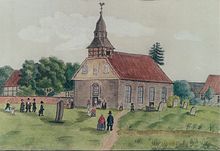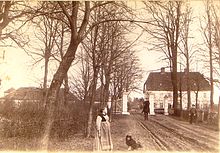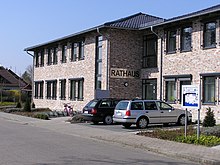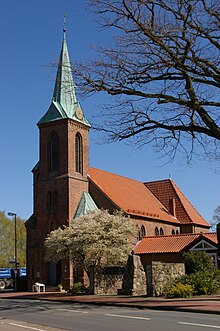Wagenfeld
| coat of arms | Germany map | |
|---|---|---|

|
Coordinates: 52 ° 33 ' N , 8 ° 35' E |
|
| Basic data | ||
| State : | Lower Saxony | |
| County : | Diepholz | |
| Height : | 37 m above sea level NHN | |
| Area : | 117.36 km 2 | |
| Residents: | 7225 (Dec. 31, 2019) | |
| Population density : | 62 inhabitants per km 2 | |
| Postal code : | 49419 | |
| Primaries : | 05444, 05774 | |
| License plate : | DH, SY | |
| Community key : | 03 2 51 044 | |
| LOCODE : | DE WGF | |
| Address of the municipal administration: |
Pastorenkamp 25 49419 Wagenfeld |
|
| Website : | ||
| Mayor : | Matthias Kreye (independent) | |
| Location of the municipality of Wagenfeld in the district of Diepholz | ||
Wagenfeld is one in the south of the county Diepholz located unified community with the districts Wagenfeld in the western and Ströhen in the eastern part.
geography
Geographical location
Wagenfeld is roughly halfway between the cities of Bremen (70 km) in the north and Osnabrück (50 km) in the southwest. To the north-west it lies on the foothills of the Kellenberg and has the highest elevation there of approx. 69 m above sea level. NN (Bockeler Berg). The difference in altitude is between 33 m above sea level. NN up to 69 m above sea level NN.
Wagenfeld has a total area of 117.36 km² of which 76.35 km² in the Wagenfeld district and 41.01 km² in Ströhen. Moor area is 13.90 km² = 8.5%. In or on the edge of the municipality there are these larger moor areas clockwise: Neustädter Moor , Renzeler Moor , Großes Moor , Oppenweher Moor and Rehdener Geestmoor .
Rivers and streams
The municipality is traversed by several small brooks, which were mainly used to reclaim the moors. Larger rivers are the Wagenfelder Aue , a southeastern tributary of the Hunte , and the Große Aue in the southeastern area near Ströhen, which is a tributary of the Weser .
geology
- Bockeler Berg: compression moraines , podsol , brown earth
- At the foot of the Bockeler Berg, on the Pustel, parts of Butzendorf: drifting sand and Podsol
- Förlinger Moor and peripheral areas of the Bockeler Moor: Niedermoor
- Neustädter Moor, central Bockeler Moor: high moor
- Along the Great Aue: Auesand, Niedermoor- Gley , Moor
- Other Wagenfelder and Ströher areas: Niederungssand-Gley-Podsol, Moor-Gley
Expansion of the municipal area
The distance between the outermost border points is 9.5 km from north to south and 18 km from west to east.
Community structure
The unitary community Wagenfeld consists of the formerly independent communities Wagenfeld-Bockel, Wagenfeld-Förlingen, Wagenfeld-Haßlingen, Wagenfeld-Neustadt and Ströhen .
Neighboring communities
Neighboring communities are - clockwise from the north: Samtgemeinde Rehden , Samtgemeinde Kirchdorf , Samtgemeinde Uchte ( district of Nienburg ), Rahden and Stemwede (both districts of Minden-Lübbecke , North Rhine-Westphalia ) and the combined community of Altes Amt Lemförde .
history
The name Wagenfeld appears for the first time around 1280 in a register of the counts' ravensberg estates. The name is derived from Wakenfeld . Waken are pools of water that occur in the swamp and swamp landscapes of the moorland.
At the end of the 15th century , the Counts of Diepholz had a protective fortress called Auburg built on the Wagenfelder Aue flowing through the village . This moated castle , located on an island between a branched off arm of the floodplain and the Wagenfelder floodplain, was intended to deter the neighboring residents of Minden , who then regularly invaded the area. However, they felt provoked by the construction of the Auburg and destroyed it several times in the period that followed.
When Count Friedrich II. Von Diepholz died in 1585 , a legal dispute broke out over the territorial affiliation of the Auburg office , at the end of which it fell to the Landgraviate of Hesse-Kassel . In 1592 the son of the landgrave , Philipp Wilhelm von Cornberg , took office. After his death, the estates were divided among his numerous descendants and, in addition to the Auburg line, a Richelsdorfer, Kettenbacher, Hüffer and a Lübbecker von Cornberg line were formed.
His eldest son Bernd Philip donated the Auburg line and after his death in 1630 he was buried as the first head of the Auburg line in the church of Wagenfeld. When the Richelsdorf line of the Cornberger family died out in the fourth generation in 1739, Richelsdorf fell to the Auberger line, which in turn moved to Richelsdorf in 1762.
19th century
During the Napoleonic Wars , Wagenfeld belonged to the Rahden canton of the Minden arrondissement in the Oberems department of the French Empire from 1810 to 1813 . After Napoleon's unsuccessful Russian campaign, French troops fled the area in 1813.
On September 23, 1815 - 230 years after the split from Diepholz in 1585 - Prussia , Hanover and Kurhessen agreed to cede the office of Auburg to Hanover. In 1820, the Auburg District Bailiwick was again affiliated to the Diepholz Office .
The coupling of Wagenfeld from 1853 to 1861 resulted in the separation between the holdings of the Auburg estate and the private areas. The farmers were released from their dependency on a landlord and could henceforth obtain private property. In addition, the road and water network has been comprehensively restructured. The four localities of Bockel, Neustadt, Förlingen and Haßlingen were handed over to the administration of a mayor (at that time still called velvet chief) for the first time. The regional tradition that Wagenfeld was “the largest village in Germany” also dates from this time, because the new municipality was of an unusual size compared to other municipalities at the time.
During the annexation of the Kingdom of Hanover, Wagenfeld fell to Prussia after the German War in 1866 and was assigned to the province of Hanover and, from 1885, the Diepholz district .
In 1884 the royal Hanoverian chamber councilor, Karl Ludwig Viktor von Cornberg zu Auburg , was appointed baron and a year later the King of Prussia enfeoffed the Auburg for the last time. When he died childless in 1891, his distant relative Theodor von Cornberg inherited the Auburg. As early as 1904 he sold the extensive property at Auburg and Wagenfeld and died as the last Auburg von Cornberg to die in the small town of Neckarelz in Baden .
20th century
In 1908, the then district administrator William "Willy" Quassowski of the Diepholz district converted all four districts of Wagenfeld into political communities with their own elected councilors so that they could more easily receive state subsidies for school maintenance. The whole of Wagenfeld became one municipality with four member municipalities.
In 1932 Wagenfeld became part of the newly created district of Grafschaft Diepholz from the districts of Diepholz and Sulingen .
In 1937, the municipality of Wagenfeld acquired the Auburg building and 26 acres of land (around 6.5 hectares ). During the Nazi regime, twelve Jewish citizens formerly resident in Wagenfeld and their spouses were deported from their former homes to six different ghettos and concentration camps (Auschwitz, Riga, Stutthof, Theresienstadt, Treblinka and Trostinez) and murdered. A further 20 Jewish wagon fields were able to flee, mostly to the USA, Great Britain, Palestine or Argentina by 1938. Since September 14, 2008, a memorial tree with a memorial plaque near the Auburg manor has been commemorating the Wagenfeld victims of the Shoa .
From May 1946 to October 1948, the British military administration formed a municipal director's district with the municipalities of Rehden, Hemsloh, Barver, Wagenfeld and Hannoversch Ströhen based on the model of the British local government, the administrative center of which was set up in the Auburg. In October 1948 all director districts in Lower Saxony were dissolved and all former municipalities were re-occupied with mayors.
On November 25, 1966, the Lower Saxony state parliament passed the “Wagenfeld Law” to dissolve the integrated community and create the unitary community of Wagenfeld from the four communities of Wagenfeld-Bockel, Wagenfeld-Förlingen, Wagenfeld-Haßlingen and Wagenfeld-Neustadt. The law came into force on January 1, 1967. On March 1, 1974, the municipality of Ströhen was incorporated. The basis for this was the "Law on the reorganization of the municipalities in the area of Grafschaft Diepholz / Grafschaft Hoya / Delmenhorst" of November 8, 1973.
Today only the mansion and servants' house is on the site of the Auburg. After 1945, refugee families lived there for eight years. After that, the building served as an agricultural vocational school until 1967 .
In 1977 Wagenfeld became part of the newly created district of Diepholz from the districts of Grafschaft Diepholz and Hoya .
21st century
In 1998/1999 the historic Auburg building was restored. Since then, the “Kulturkreis Auburg” has offered a varied cultural program on its premises.
From 1961 to 2002, Wagenfeld was a Bundeswehr location : the Luftwaffe maintained the 3rd battery of the anti-aircraft missile battalion 25 (3./FlaRakBtl. 25), which was assigned to the 4th Air Force division ( Aurich ). In 1975 the unit's accommodation area was given the name "Auburg Kaserne". Soldiers from the 42nd US Artillery Division were stationed in Wagenfeld until 1988, guarding the small number of nuclear warheads that would have been shot down by Bundeswehr soldiers in the event of a defense - after clearance by the Americans. Initially, conventional Nike Ajax missiles were used as the weapon system, followed by Nike Hercules missiles (with both conventional and nuclear warheads) for many years , which were finally replaced in 1989 by the MIM-104 Patriot (conventional). The conversion to the Patriot system made the small US garrison superfluous. In the course of its downsizing after the end of the East-West conflict , the Bundeswehr finally closed its Wagenfeld location. You can still see the barracks , the cleared missile launch site ( bunker ) and the former fire control area (former radar display ).
In 2005 the municipal administration moved into a wing of the new “Wagenfeld service center”, while the old town hall on Hauptstrasse no longer exists today.
politics
Municipal council
The municipality council of the municipality of Wagenfeld consists of 20 councilors and councilors as well as the mayor. This is the specified number for a municipality with a population between 7,001 and 8,000. The 20 council members and the mayor are elected for five years each by local elections. The current term of office began on November 1, 2016 and ends on October 31, 2021.
The following table shows the local election results since 2001.
| Council of the municipality of Wagenfeld: election results and municipal councils | |||||||||||||||||||
|---|---|---|---|---|---|---|---|---|---|---|---|---|---|---|---|---|---|---|---|
| CDU | SPD | FDP | UWG | total | electoral participation |
electoral legitimate |
Voters | ||||||||||||
| Electoral term | % |
|
% |
|
% |
|
% |
|
% |
|
% | ||||||||
| 2001-2006 | 45.30 | 10 | 22.10 | 4th | 14.80 | 3 | 17.80 | 3 | 100 | 20th | 51.20 | 5,848 | 2,997 | ||||||
| 2006-2011 | 42.29 | 9 | 20.23 | 4th | 16.55 | 3 | 20.90 | 4th | 100 | 20th | 51.61 | 5,938 | 3,065 | ||||||
| 2011-2016 | 44.24 | 8th | 21.02 | 4th | 12.52 | 2 | 20.20 | 4th | 100 | 18th | 48.56 | 5,897 | 2,864 | ||||||
| 2016-2021 | 44.24 | 9 | 21.02 | 3 | 12.52 | 3 | 20.20 | 5 | 100 | 20th | 53.54 | 5,900 | 3.159 | ||||||
| Sources: Wagenfeld community. | |||||||||||||||||||
mayor
Matthias Kreye, a non-party member, has been the full-time mayor of the Wagenfeld community since November 2014 . In the last mayoral election he was elected with 63.78% of the vote against three competitors. The turnout was 61.24%. Kreye replaced the previous incumbent Wilhelm Falldorf (CDU), who had no longer run.
In 1997, the two-pronged community head in Wagenfeld, which had existed since 1946 , with a full-time community director and an honorary mayor, was given up under the North German council constitution . The community directors were the joint mayors from 1946 to 1962. On July 1, 1962, Karl-Heinz Placke was appointed joint community director, from 1967 as community director in the unified community until February 28, 1995. Henning Albers then took over for the last two years (1995–1995). 1997) the office.
See also: List of mayors and incumbents of Wagenfeld
coat of arms
Blazon : The coat of arms is divided. Above in silver a striding red lion. Below is a shaft of blue and silver arranged in three rows of five.
Description: The municipal coat of arms is borrowed from the family coat of arms of the Barons von Cornberg and is only slightly different in color. The striding lion represents the family's descent from the Landgraves of Hesse. The chess stands in the family coat of arms for a chessboard and is held in the family coat of arms in the colors blue, red and silver. The municipality of Wagenfeld shares this coat of arms, each time changed in the color of the slaughtered field, with the municipality of Cornberg .
Town twinning
Wagenfeld has had a partnership with the French canton of Vibraye since 1977 .
Culture and sights
Auburg
From the former castle of the Auburg of the Middle Ages, only the mansion and servants' house is located on the site today. Other buildings and halls are used by the local building yard .
theatre
In the Wagenfeld open-air theater ("Freilichtbühne Wagenfeld"), Low German amateur theater is shown every summer.
Animal park
Animals from all over the world can be found in the Ströhen zoo , which is open all year round . In the zoo there is also the thoroughbred Arab stud Ismer .
Jewish Cemetery
The Jewish cemetery in Wagenfeld is a cultural monument . It is one of eight well-preserved Jewish cemeteries in the Diepholz district. In the cemetery in a small wood on “Barver Straße” there are 27 gravestones from the years 1811 to 1927 of the Jewish deceased.
EFMK
Since 2014, the European Center of Expertise Mire and Climate (EZFM) with a crane-shaped exhibition and administration building has been located in the north of the Ströhen district.
Draisine traffic and moor railway
On the former Rahden - Ströhen (Han.) Railway line , there is now a railroad trolley service for tourists. The “lane change” then takes place in Ströhen, because a former moor railway that has been converted into a tourist railway connects here. The approximately 3.5 km long route leads to the Neustädter Moor nature reserve . It ends near the Schäferhof Teerling, where a moor pad begins in the moor.
Söhler's windmill
In 1905 the mill was built by Friedrich Söhler. It is built as a transit Dutchman with a four-story substructure and upper part made of bricks. The mill is equipped with sail blades, cap and oak shingles. In 1990 it was completely restored and was also used as a wedding mill for some time.
Associations
Wagenfeld is a member of several nature and cultural associations: Diepholzer Moorniederung , Dümmer Nature Park , DümmerWeserLand, Lower Saxony Asparagus Route and Lower Saxony Mühlenstrasse .
Regular events
The Wagenfeld wholesale market has been held on the last Friday in August for over 425 years. From the initial dancing and trading of the rural population, an amusement market has developed over time.
The MSC Heidering Wagenfeld motorcycle sports club regularly organizes speedway training on the Heidering . Particularly noteworthy is the large Easter training on Holy Saturday .
Choirs
Mixed choir, pop choir and KiChoWa (= Wagenfeld children's choir) enrich the cultural life in Wagenfeld with their public appearances.
Culinary specialties
- Ströher Schwarten: drink consisting of 1/3 water, 1/3 finest coffee beans and 1/3 grain
- Pickert : pancake-like dish made from grated potatoes
Economy and Infrastructure
economy
The larger companies based in Wagenfeld include:
- Friedrich Lütvogt (Auburg spring)
- Wagenfeld Dairy
- PTW Polyurethan -Technik Wagenfeld
- Wagenfeld spinning mills (wool mill)
- ZF Friedrichshafen AG (car wheel joints plant)
education
- Two primary schools (Auburg school in Wagenfeld and Ströhen primary school)
- Secondary school in Wagenfeld
- the upper level can be attended in the grammar schools in the surrounding towns: Graf-Friedrich-Schule (Diepholz) , Rahden and Sulingen
- VHS of the district of Diepholz has a job here
- Community library in the basement of the Auburg school
Public facilities
- Town hall, Pastorenkamp 25
- Wagenfeld voluntary fire brigade with its locations in Wagenfeld and Ströhen as well as two youth fire brigades
- Wagenfeld police station
Social facilities
- Kindergartens
- Ev. Kindergarten Dandelion in Wagenfeld
- DRK kindergarten in Ströhen
- German Red Cross, Wagenfeld and Ströhen local associations
- Two senior facilities
Leisure and sports facilities
- eight football and soccer fields
- three sports halls (two single-field sports halls at the elementary schools in Wagenfeld and Ströhen and a three-field sports hall at the secondary school in Wagenfeld)
- Tennis facility with three courts in Wagenfeld
- Indoor swimming pool in Wagenfeld
- seven shooting ranges
- Paintball facility (on the former military site)
- 18-hole golf course
- Heide-Ring speedway track
Churches, religions
- Two Evangelical Lutheran parishes
- St. Antonius in Wagenfeld with a Bible garden laid out in 2013
- Parish Ströhen
- A mosque
traffic
Road traffic
Wagenfeld can be reached via the B 239 , which crosses the municipality from northwest to southeast and runs directly through the village of Wagenfeld. In addition, the municipal area is densely developed by several state roads: L 343 , L 344 , L 345 , L 347 and L 349 . In Holdorf there are motorway connections to the A 1 (40 km) via the B 239 and B 214 in the west and Kirchlengern to the A 30 (44 km) and A 2 directly via the B 239 in the south.
A bypass road is planned around the center of Wagenfeld and has been included in the Federal Transport Infrastructure Plan 2030 as an "urgent need".
Public transportation
There are two daily bus routes operated by Weser-Ems Busverkehr and Lahrmann Bus:
- Line 133 from Rahden ( Rahden station with operation by the Eurobahn ) via Wagenfeld to Sulingen .
- Line 170 from Diepholz ( DB train station ) via Wagenfeld to Ströhen.
In addition, several lines ensure school traffic during school hours. The community is located in the tariff area of the Bremen / Lower Saxony transport association .
Rail transport
In Ströhen there is an inactive train station on the Rahden – Bassum railway line . Passenger traffic ceased on May 22, 1982. The final shutdown followed on June 1, 1994.
There are currently trolley trips for tourists between Rahden and Ströhen .
The “Action Alliance for the Bassum-Bünde Railway” plans to reactivate it north of Rahden as the “Dümmer-Weser Railway” and to operate passenger transport by the Bonn Rhein-Sieg Railway by 2020.
Personalities
Sons and daughters of the church
- Ingo Eichmann (1901- † after 1969), Gestapo officer and SS leader, born in the Ströhen district
- Fritz Wilkening (1926–2016), teacher and educational scientist
People associated with the community
- Adam von Cornberg (born June 23, 1659; † 1728 in Auburg), captain
- Baron Karl Ludwig Viktor von Cornberg zu Auburg († 1891), last representative of the Auburg line
- Jan Hinnerk Wördemann (born May 1, 1851 in Dörpel , † December 18, 1923 in Wagenfeld), local poet
literature
- Wilhelm Falldorf: 'Has everyone heard?' Tell other story-like stories in Wagenfeld and Ströhen. Wagenfeld 1986, 72 pp.
- Wilhelm Falldorf: Wagenfeld and Ströhen. A historical overview. Wagenfeld 1988.
- Wilhelm Falldorf: Wagenfeld and Ströhen in old pictures. Volume I (Ed .: Wagenfeld municipality), Wagenfeld 1986, 96 p. M. 80 fig.
- Timo Friedhoff: Church and Church History in Wagenfeld. Wagenfeld 2001
- Timo Friedhoff: 'Guide to my life ...' - The life of Baroness Henriette von Cornberg-Auburg, b. Freiin von Freitag-Daren. (Monograph), Wagenfeld 2001
- Timo Friedhoff: Wagenfeld fragments. The history of Wagenfeld's Jewish community from the 18th to the 20th century. Geest-Verlag, Vechta-Langförden 2008; ISBN 978-3-86685-138-2
- Julius Hummel: Chronicle of the community Wagenfeld and the office of Auburg. (Ed .: Wagenfeld municipality), Wagenfeld 1972, 209 p. With numerous Fig.
- Rolf Ismer: The Ströhen Nature Park. Wagenfeld 2001.
- Almuth Lessing: Wagenfeld. In: Herbert Obenaus (Ed. In collaboration with David Bankier and Daniel Fraenkel): Historical manual of the Jewish communities in Lower Saxony and Bremen . Volume 1 and 2 (1668 p.), Göttingen 2005, pages 1524-1527
- Gerold Schmidt: The Scheide family. Part I: The origin from Wagenfeld (Diepholz district) and expansion to Oldenburg. Oldenburg family history, volume 1/2, year 38/1996, 106 pp.
Web links
- Website of the municipality of Wagenfeld
- ( Page no longer available , search in web archives: Brief history of the Auburg office )
Individual evidence
- ↑ State Office for Statistics Lower Saxony, LSN-Online regional database, Table 12411: Update of the population, as of December 31, 2019 ( help ).
- ↑ http://www.richelsdorf.de/Geschichte/700Jahre.php5#cornberger
- ↑ http://www.richelsdorf.de/Geschichte/700Jahre.php5#cornberger
- ^ Federal Statistical Office (ed.): Historical municipality directory for the Federal Republic of Germany. Name, border and key number changes in municipalities, counties and administrative districts from May 27, 1970 to December 31, 1982 . W. Kohlhammer GmbH, Stuttgart and Mainz 1983, ISBN 3-17-003263-1 , p. 190 .
- ↑ Archived copy ( memento of the original dated August 7, 2012 in the Internet Archive ) Info: The archive link was inserted automatically and has not yet been checked. Please check the original and archive link according to the instructions and then remove this notice. / The story of Wagenfeld
- ↑ http://www.bau-team-husmann.de/reierungen/gewerbebauten/dlz-wagenfeld/
- ^ Lower Saxony Municipal Constitutional Law (NKomVG) in the version of December 17, 2010; Section 46 - Number of MPs , accessed on December 6, 2014
- ↑ Final results of the municipal council election on September 11, 2016 ( Memento of the original from November 16, 2016 in the Internet Archive ) Info: The archive link was inserted automatically and has not yet been checked. Please check the original and archive link according to the instructions and then remove this notice.
- ↑ Individual results of the direct elections on May 25, 2014 in Lower Saxony , accessed on December 6, 2014.
- ↑ http://www.spurwechsel-wagenfeld.de/
- ↑ http://www.niedersaechsische-muehlenstrasse.de/index.php?id=160
- ↑ Wagenfeld Choirs. Retrieved July 11, 2016 .
- ↑ http://www.tus-wagenfeld.de/
- ↑ http://www.paintball-wagenfeld.de/
- ↑ http://www.golfpark-wagenfeld.de/
- ↑ Evangelical Lutheran parish of St. Antonius Wagenfeld: Welcome to the Wagenfeld Bible Garden "Blickwechsel"
- ↑ Shire Draisinen
- ^ Action alliance for the Bassum-Bünde railway line

















